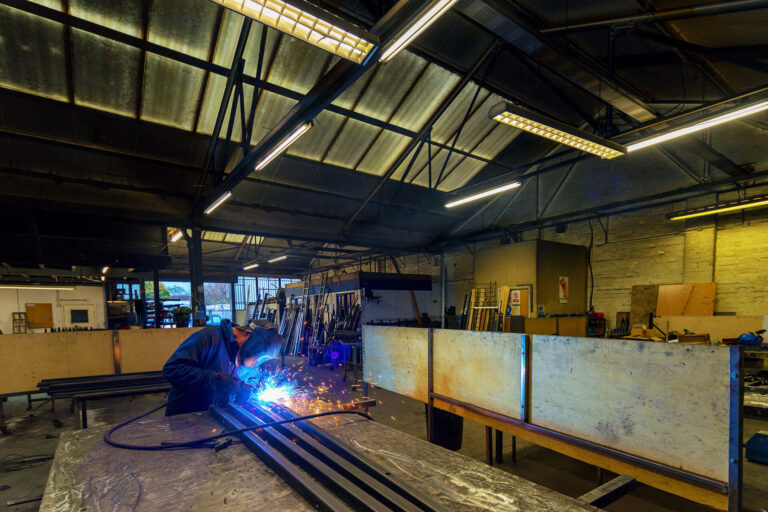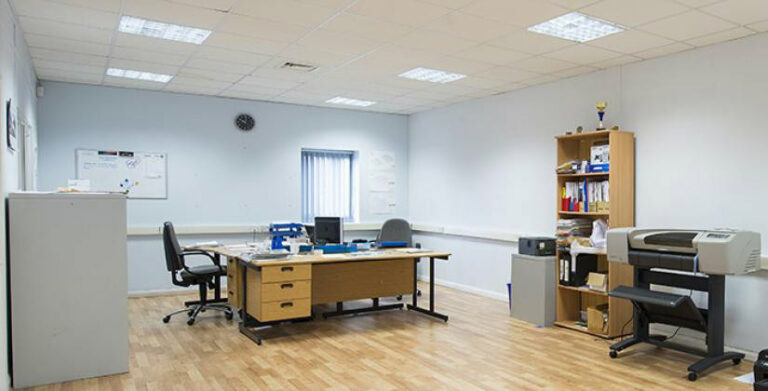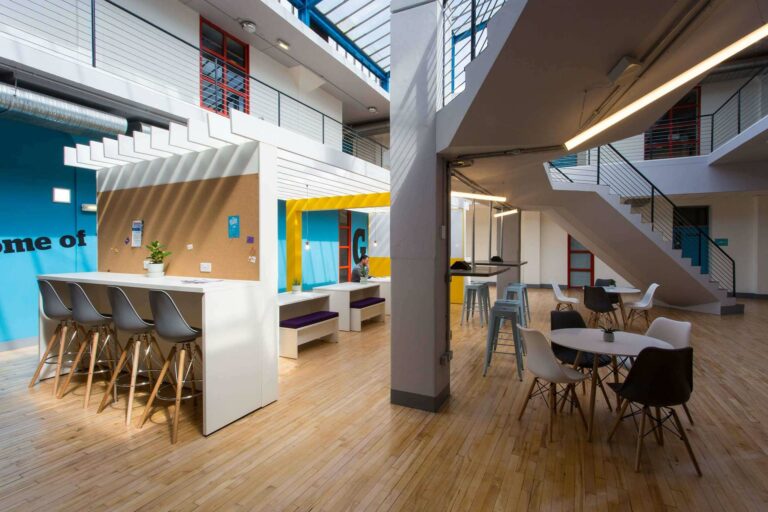With the COVID-19 vaccine programme now well underway, you may be starting to think about what returning to the office after the lockdown could look like. The Government’s lockdown roadmap states that you should ‘continue to work from home where possible’ until at least June, but putting preparations in place at this stage will stand you in good stead for a smooth transition back to the workplace when the time comes.
At BizSpace, we’re always here to help. That’s why we’ve put together this handy guide to returning to the office after lockdown restrictions have eased. Join us as we explore all of the important considerations, including making and communicating the decision to return, COVID-19 risk assessments, implementing new guidelines, and safeguarding mental health.

Making the decision to return and communicating to staff
Even as the coronavirus situation settles, it’s important not to get ahead of yourself when deciding to return to the office. Keep checking in with the Government’s latest guidance for working safely during coronavirus and have an eye on the news. The latest advice is still to work from home where possible until June 2021, and your decision to return to the office after lockdown eases should be driven primarily by official guidance.
An equally important consideration is the readiness of your staff to return. Of course, getting back into the office is ultimately your call. At the same time, you’ll get the best out of your team and avoid any unnecessary conflict by approaching the situation as sensitively as possible. Asking line managers to have informal chats about the process with their direct reports is an excellent place to start – your staff are more likely to share how they’re really feeling this way.
One possibility is introducing hybrid working, with employees coming in on some days and working from home on others. This will make for a much smoother transition back into the office and give your team the best of both work approaches. By organising shift patterns based on a rota, you can also keep numbers down and create a more COVID-secure environment that people feel comfortable returning to.
Once businesses are given the all-clear and you’ve decided that your organisation is ready, communicate your plans to staff. There are plenty of good reasons for holding off any company-wide communications until this stage:
- Informing employees about plans to return before the government go-ahead could result in your having to backtrack at a later date;
- You could inadvertently unsettle your staff by starting the process before your plans are entirely in place;
- As you’ll see over the course of this guide, there are lots of factors to consider – delaying your communications will give you as much time to prepare as possible.
COVID-19 risk assessments: ensuring the office is safe
The safety of your employees is the most critical consideration when returning to the office after lockdown. A complete COVID-19 risk assessment is the first item on the agenda. Below, we’ll run through the key elements to look into and the provisions you can make to ensure that the office is safe.
Maintaining social distance
First and foremost, you need to ensure that your office setup allows for social distancing. HSE still advise that staff should maintain a distance of two metres apart where possible. Reducing the number of employees who come in at any one point in time will help to allow for social distancing, but changes may also need to be made to the office environment itself.
You might need to reorganise the layout of desk spaces and meeting rooms. If the desks in the office would usually be closer than two metres apart, then remove the chairs and equipment from every other space and avoid positioning employees so that they’re sat opposite each other – it’s likely that this will also apply to meeting rooms and other communal and confined seating areas.

You should consider communal areas as part of your risk assessment. Introduce floor markings at a distance of two metres apart in places like toilets, break out areas, and canteens to support social distancing. Some facilities, such as urinals, don’t allow for two-metre separation – alternate these so that staff can stand far enough apart.
Even with all of these physical changes to the office in place, you should still introduce new policies like one-way systems so that employees can maintain social distance at all times (more on this and other guidelines for reducing congestion below).
Allowing adequate ventilation
Proper ventilation of rooms is one of the most effective ways to stop the virus from spreading: the more fresh air you bring into an indoor environment, the quicker any airborne virus will be removed from the space. With this in mind, thinking about how well-ventilated workspaces are should be a key part of your risk assessment before returning to the office.
Identify which areas throughout the office have access to nearby ventilation via an open window or air filtration system and which don’t. The rooms’ size is also worth considering: there’s much less risk of transmitting the virus in a larger space. Once you’ve identified the confined locations with poor ventilation, consider closing them off or limiting access if possible.
In general, the ventilation in your office can be improved by leaving windows open throughout the day. Equally, ensuring that any fans and ducts are left on to keep bringing outside air in will help.
Providing hand sanitiser and handwashing facilities
As we’re all aware, keeping hands and workspaces clean is a vital part of protecting against coronavirus, so the physical environment of your office should support this as much as possible. Positioning hand sanitiser stations around the workplace and placing bottles on individuals’ desks is a must ahead of the return to the office; providing sanitiser at entry and exit points is likewise a good idea.
You should review whether the number of handwashing facilities in your office is suitable for your workforce (and look to instal more if not). Make sure that these are easily accessible, have running water, and are kept well-stocked with hand soap and paper towels.
Introducing appropriate signage
Most people will be well aware of the precautions we need to take by now, but the use of signage around the office to remind staff is advisable. In addition to the standard social distancing and hygiene messaging, it will also be essential to highlight any one-way systems or other congestion-reducing policies in place using clearly visible signs (more on this below).
Creating and implementing new guidelines
As well as adapting the physical environment, you’ll need to put clear guidelines in place to help keep everyone safe when planning your return to the office. The key areas to consider from a people and processes perspective are reducing the build-up of staff in any one place, ensuring strict cleaning measures are adhered to, and testing for COVID-19 cases on a regular basis.
Reduce congestion in high-traffic areas
There are lots of policies you could implement to help reduce congestion around the office, allowing for social distancing and minimising contact altogether where possible. Some potential ideas include:
- One-in/one-out policies – having worked out the poorly ventilated and confined spaces during your risk assessment, you may want to implement one-in/one-out policies so that staff never come into contact with others in tightly packed places like lifts, postal rooms, toilets, and kitchens.
- One-way systems – consider introducing one-way systems to congested zones like the aisles between desks, corridors, and stairways, with clearly visible floor markings to indicate that a system is in place.
- Staggering break times – to avoid a mass rush to lunch and reduce the number of employees in canteens and break areas, bring in a system of staggered break times.
Whenever you implement any systems like these, communicate them clearly to staff and introduce clear signage to avoid any confusion.

More thorough cleaning measures
Introducing a system of thorough and more regular cleaning will be vital when returning to the office. You should have the space cleaned at least once a day, with cleaners wiping down all surfaces with an antiviral solution. Ensure that your cleaning staff are focusing on the following as part of their daily clean:
- Toilets and doors
- Door handles
- Light switches
- Desks
- Tabletops
- Kitchen surfaces
- Cupboard handles
Communal areas where surfaces are touched frequently should also be cleaned in between (for example, after lunch). Provide cleaning equipment in these places so that your staff can see to this themselves. It’s also a good idea to encourage employees to sterilise their own work areas with alcohol wipes before they go home at the end of the day.

At BizSpace centres, all shared areas that aren’t occupied by an organisation will be deep cleaned by our staff on a regular basis. Check out our COVID-19 customer FAQs to learn more.
Temperature checks and COVID testing
If it’s possible for your business to introduce thermal scanning temperature checks for staff as they enter the building, we’d recommend doing so before returning to the office. One of the main symptoms of COVID-19 is a fever. Using cameras that detect body heat, you can identify possible coronavirus cases before people come into the office.
That said, this doesn’t account for cases where the sufferer is only experiencing the other symptoms of a continuous cough or a change in their sense of smell – and some carriers can be asymptomatic. The best option is to combine temperature checks with regular tests. Businesses can now register to receive free lateral flow blood tests for employees provided by the Government, so this is a step you should take as part of your preparations.
Safeguarding employees’ mental health
The challenges of returning to the office after lockdown are only partly physical. It’s important not to underestimate the psychological impact of a sudden change in working environment. After a long period away, the anxiety of coming back into a socially intensive setting may unsettle some employees. Equally, it’s likely that there’ll be some underlying worry about coming into contact with someone who has COVID-19 in the workplace.
Against the backdrop of these potential triggers, a sensitive and considered approach to safeguarding employees’ mental health is required. In the first instance, make your staff aware that the organisation appreciates how challenging it might be for people when coming back to the office to begin with. A simple show of solidarity like this will ensure that no team member feels like they’re suffering alone.
If you offer an Employee Assistance Programme or another similar scheme, make sure that all of your staff are aware and reiterate the value of the support that they can access through it. Within the organisation, ask line managers to have frank and open conversations with their direct reports throughout the return-to-work process – simply checking in will be helpful in its own right, but handling specific issues with compassion should also help staff to settle back in.

As well as engaging with employees who are experiencing mental health issues, try to promote behaviours that contribute to better mental wellbeing. Encouraging everyone to talk more openly about how they’re feeling is an excellent place to start. On top of this, you could also look into initiatives that inspire people to exercise more, eat healthily, and make sure that they’re getting enough sleep, all of which will help during the transition back to the office.
This guide has explored the process of returning to the office after lockdown. Along the way, we’ve covered all of the main points for employers to think about, including making the decision to bring staff back in, carrying out COVID-19 risk assessments, implementing new policies, and looking after employees’ mental wellbeing.
BizSpace is the UK’s leading provider of flexible office space. If you’re looking for new office premises, don’t hesitate to get in touch using the enquire button at the top of this page or try out our handy office search tool to find your ideal location.
Author:
BizSpace
BizSpace is the UK’s leading provider of regional flexible workspace. For over 20 years we have been offering office, studio and workshop units to a wide range of businesses in convenient regional locations across the country. We are owned by Sirius Real Estate, a commercial property operator, that is supporting us on a journey to significant growth.
More BizSpace News

Blog
Finding a Small Industrial Unit or Workshop to Rent
Let’s be honest with each other, finding a ‘perfectly sized’ industrial unit for your business isn’t exactly fun. It’s time-consuming,…
Find out more
Blog
Designing your ideal office: 8 top tips
Focus on comfort and practicality when designing your office space, considering layout, light, furniture, clutter and accessories.
Find out more
Blog
What is a Satellite Office?
Businesses are now finally able to return to some sense of normality in our post-COVID society. There has been plenty…
Find out more